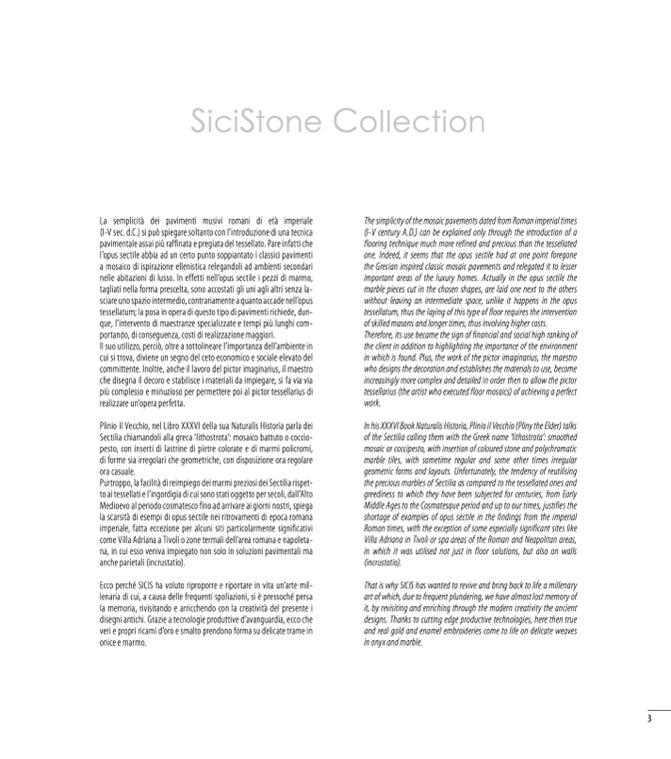
SiciStone Collection
La semplicità dei pavimenti musivi romani di età imperiale
(I-V sec. d.C.) si può spiegare soltanto con l’introduzione di una tecnica
pavimentale assai più raffinata e pregiata del tessellato. Pare infatti che
l’opus sectile abbia ad un certo punto soppiantato i classici pavimenti
a mosaico di ispirazione ellenistica relegandoli ad ambienti secondari
nelle abitazioni di lusso. In effetti nell’opus sectile i pezzi di marmo,
tagliati nella forma prescelta, sono accostati gli uni agli altri senza la-
sciare uno spazio intermedio, contrariamente a quanto accade nell’opus
tessellatum; la posa in opera di questo tipo di pavimenti richiede, dun-
que, l’intervento di maestranze specializzate e tempi più lunghi com-
portando, di conseguenza, costi di realizzazione maggiori.
Il suo utilizzo, perciò, oltre a sottolineare l’importanza dell’ambiente in
cui si trova, diviene un segno del ceto economico e sociale elevato del
committente. Inoltre, anche il lavoro del pictor imaginarius, il maestro
che disegna il decoro e stabilisce i materiali da impiegare, si fa via via
più complesso e minuzioso per permettere poi al pictor tessellarius di
realizzare un’opera perfetta.
Plinio il Vecchio, nel Libro XXXVI della sua Naturalis Historia parla dei
Sectilia chiamandoli alla greca ‘lithostrota’: mosaico battuto o coccio-
pesto, con inserti di lastrine di pietre colorate e di marmi policromi,
di forme sia irregolari che geometriche, con disposizione ora regolare
ora casuale.
Purtroppo, la facilità di reimpiego dei marmi preziosi dei Sectilia rispet-
to ai tessellati e l’ingordigia di cui sono stati oggetto per secoli, dall’Alto
Medioevo al periodo cosmatesco fino ad arrivare ai giorni nostri, spiega
la scarsità di esempi di opus sectile nei ritrovamenti di epoca romana
imperiale, fatta eccezione per alcuni siti particolarmente significativi
come Villa Adriana a Tivoli o zone termali dell’area romana e napoleta-
na, in cui esso veniva impiegato non solo in soluzioni pavimentali ma
anche parietali (incrustatio).
Ecco perché SICIS ha voluto riproporre e riportare in vita un’arte mil-
lenaria di cui, a causa delle frequenti spoliazioni, si è pressoché persa
la memoria, rivisitando e arricchendo con la creatività del presente i
disegni antichi. Grazie a tecnologie produttive d’avanguardia, ecco che
veri e propri ricami d’oro e smalto prendono forma su delicate trame in
onice e marmo.
The simplicity of the mosaic pavements dated from Roman imperial times
(I-V century A.D.) can be explained only through the introduction of a
flooring technique much more refined and precious than the tessellated
one. Indeed, it seems that the opus sectile had at one point foregone
the Grecian inspired classic mosaic pavements and relegated it to lesser
important areas of the luxury homes. Actually in the opus sectile the
marble pieces cut in the chosen shapes, are laid one next to the others
without leaving an intermediate space, unlike it happens in the opus
tessellatum, thus the laying of this type of floor requires the intervention
of skilled masons and longer times, thus involving higher costs.
Therefore, its use became the sign of financial and social high ranking of
the client in addition to highlighting the importance of the environment
in which is found. Plus, the work of the pictor imaginarius, the maestro
who designs the decoration and establishes the materials to use, become
increasingly more complex and detailed in order then to allow the pictor
tessellarius (the artist who executed floor mosaics) of achieving a perfect
work.
In his XXXVI Book Naturalis Historia, Plinio il Vecchio (Pliny the Elder) talks
of the Sectilia calling them with the Greek name ‘lithostrota’: smoothed
mosaic or coccipesto, with insertion of coloured stone and polychromatic
marble tiles, with sometime regular and some other times irregular
geometric forms and layouts. Unfortunately, the tendency of reutilising
the precious marbles of Sectilia as compared to the tessellated ones and
greediness to which they have been subjected for centuries, from Early
Middle Ages to the Cosmatesque period and up to our times, justifies the
shortage of examples of opus sectile in the findings from the imperial
Roman times, with the exception of some especially significant sites like
Villa Adriana in Tivoli or spa areas of the Roman and Neapolitan areas,
in which it was utilised not just in floor solutions, but also on walls
(incrustatio).
That is why SICIS has wanted to revive and bring back to life a millenary
art of which, due to frequent plundering, we have almost lost memory of
it, by revisiting and enriching through the modern creativity the ancient
designs. Thanks to cutting edge productive technologies, here then true
and real gold and enamel embroideries come to life on delicate weaves
in onyx and marble.
3

